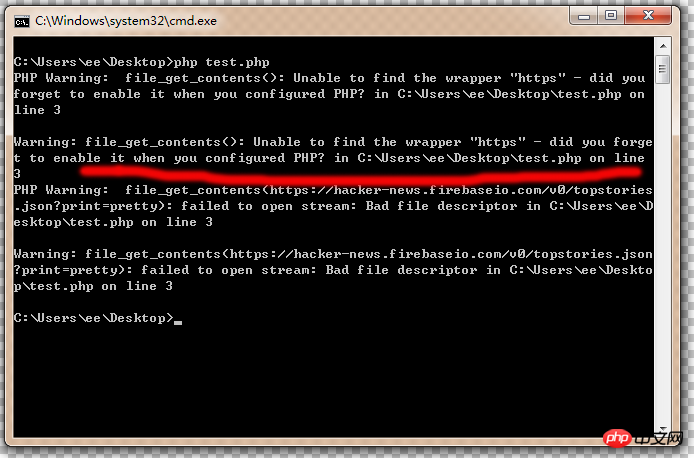
This article mainly introduces the implementation of PHP to capture HTTPS content, as well as solutions to the problems encountered. Friends in need can refer to it
I recently encountered an HTTPS problem while studying the Hacker News API. Because all Hacker News APIs are accessed through the encrypted HTTPS protocol, which is different from the ordinary HTTP protocol, when using the function <a href="http://www.php.cn/wiki/1311.html" target="_blank">file_get_contents</a>() in PHP to obtain the information provided in the API When data is being processed, an error occurs. The code used is as follows:
<?php
$data = file_get_contents("https://hacker-news.firebaseio.com/v0/topstories.json?print=pretty");
......When running the above code, the following error message is encountered:
PHP Warning: file_get_contents(): Unable to find the wrapper "https" - did you forget to enable it when you configured PHP?
The following is a screenshot:

Why does this error occur?
After some searching on the Internet, I found that many people have encountered this error. The problem is very direct, because there is no parameter enabled in PHP's configuration file. On my local machine, it is ;extension=php_openssl.dll in /apache/bin/php.ini, and the preceding semicolon needs to be removed. You can use the following script to check the configuration of your PHP environment:
$w = stream_get_wrappers(); echo 'openssl: ', extension_loaded ('openssl') ? 'yes':'no', "\n"; echo 'http wrapper: ', in_array('http', $w) ? 'yes':'no', "\n"; echo 'https wrapper: ', in_array('https', $w) ? 'yes':'no', "\n"; echo 'wrappers: ', var_dump($w);
Running the above script snippet, the result on my machine is:
openssl: no
http wrapper: yes
https wrapper: no
wrappers: array(10) {
[0]=>
string(3) "php"
[1]=>
string(4) "file"
[2]=>
string(4) "glob"
[3]=>
string(4) "data"
[4]=>
string(4) "http"
[5]=>
string(3) "ftp"
[6]=>
string(3) "zip"
[7]=>
string(13) "compress.zlib"
[8]=>
string(14) "compress.bzip2"
[9]=>
string(4) "phar"
}Alternative Solution
Discover errors and correct them. This is very simple. The difficult thing is that you cannot correct the errors after you discover them. I originally wanted to put this script method on the remote host, but I couldn't modify the PHP configuration of the remote host. The result was that I couldn't use this solution, but we can't hang ourselves on a tree. This road doesn't work. Let's take a look. Is there any other way?
Another function I often use to grab content in PHP is curl. It is more powerful than file_get_contents() and provides a lot of optional parameters. For the problem of accessing HTTPS content, the CURL configuration parameter we need to use is:
curl_setopt($ch, CURLOPT_SSL_VERIFYPEER, FALSE);
You can see from the semantics that it is ignored/skipped SSL security verification. Maybe this is not a good idea, but for ordinary scenarios, this is enough.
The following is a function that can access HTTPS content encapsulated using Curl:
function getHTTPS($url) {
$ch = curl_init();
curl_setopt($ch, CURLOPT_SSL_VERIFYPEER, FALSE);
curl_setopt($ch, CURLOPT_HEADER, false);
curl_setopt($ch, CURLOPT_FOLLOWLOCATION, true);
curl_setopt($ch, CURLOPT_URL, $url);
curl_setopt($ch, CURLOPT_REFERER, $url);
curl_setopt($ch, CURLOPT_RETURNTRANSFER, TRUE);
$result = curl_exec($ch);
curl_close($ch);
return $result;
}The above is the entire process of obtaining https content in PHP. It is very simple and practical. Recommended For friends who have the same project needs.
The above is the detailed content of PHP code example for capturing HTTPS content. For more information, please follow other related articles on the PHP Chinese website!




